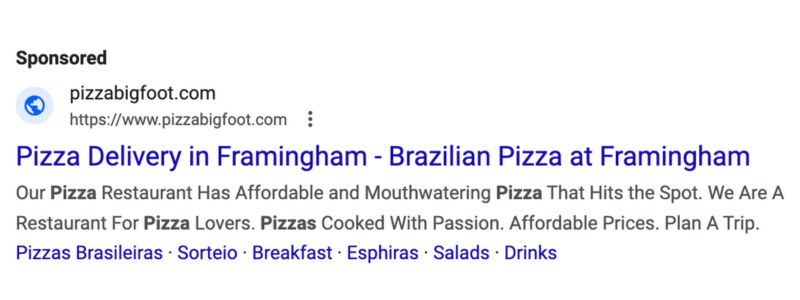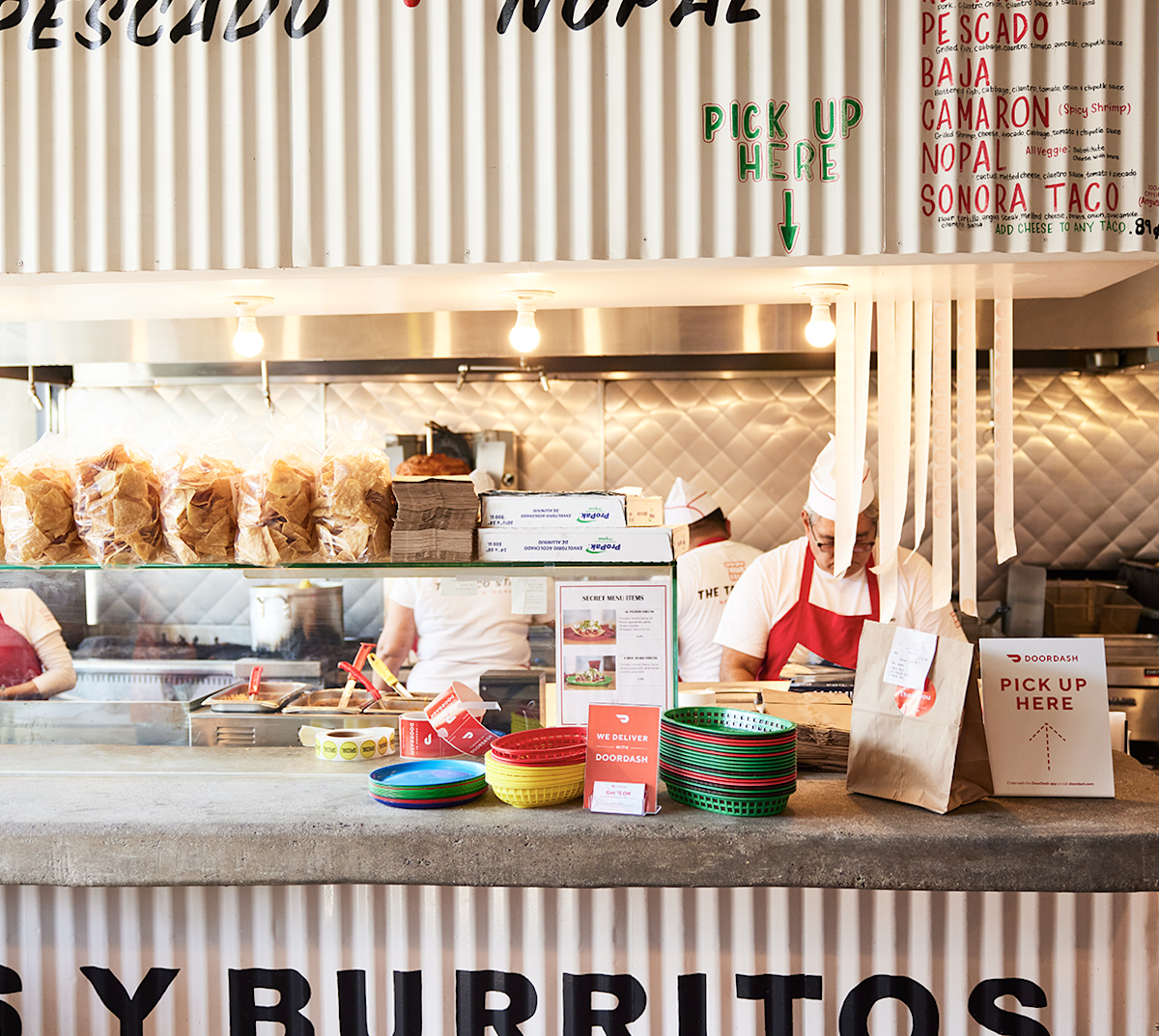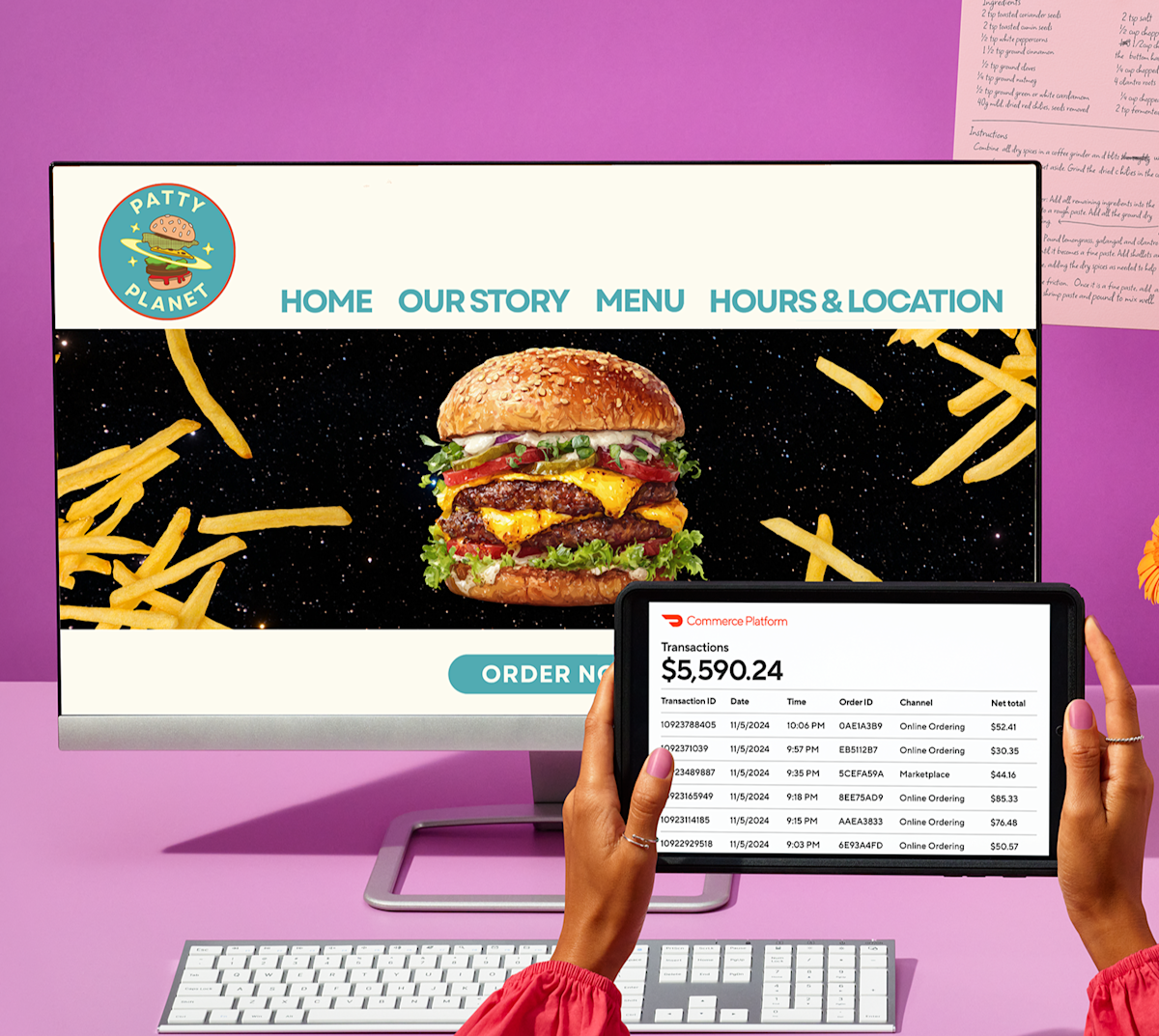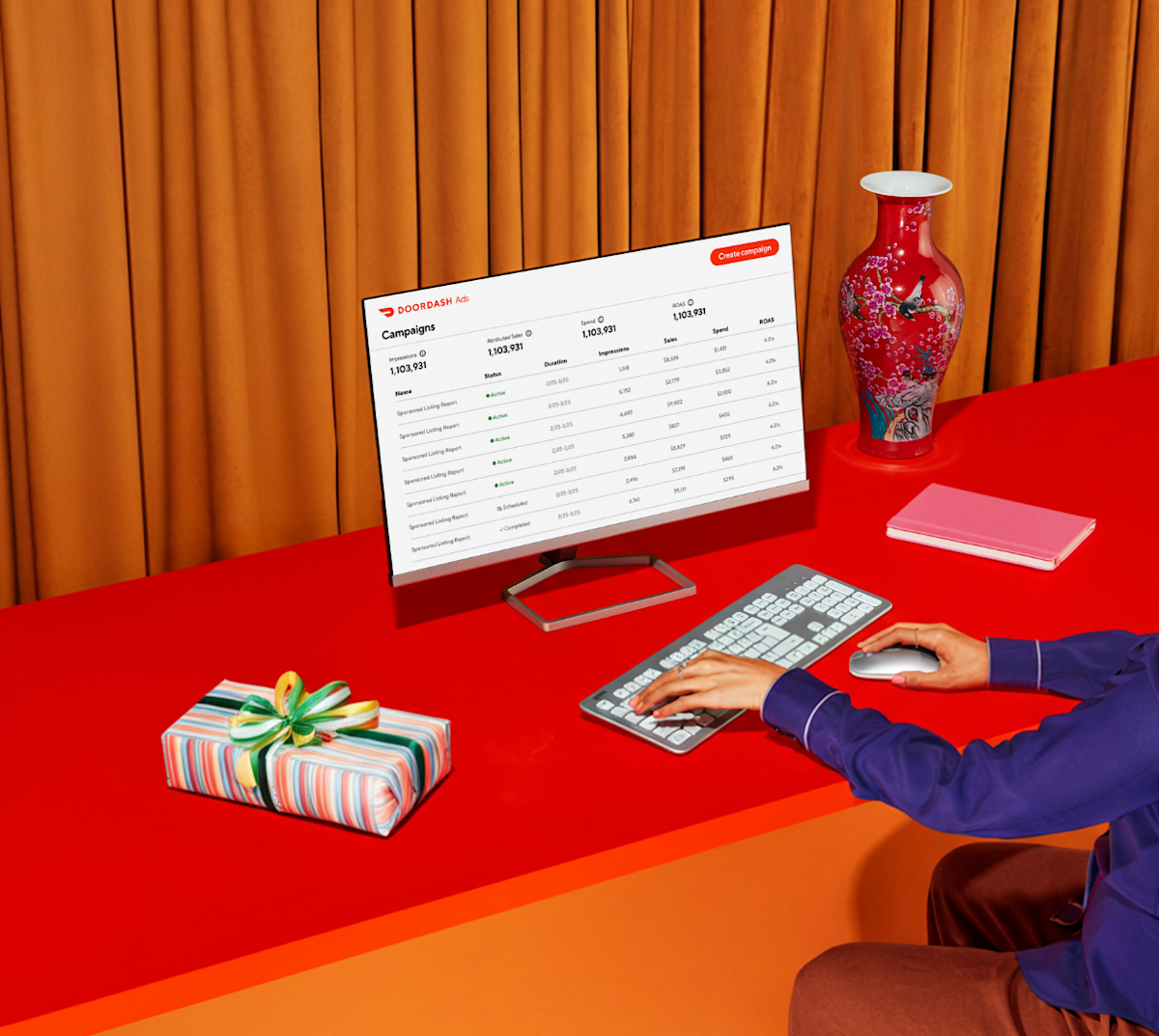Today, restaurant advertising is split between digital ads and out of home ads. We’ll get into the various ways that restaurants can attract new customers and remind previous diners that it’s time for another visit through social media posts and ads, sponsored email newsletters, and more.
Types of restaurant ads, with examples
Here are some of the most common formats for restaurant advertising, with some great restaurant ad examples for each.
Social media images
One of the easiest and most popular format options for social posts is a still image. Smartphone cameras have gotten so good that you don’t need professional cameras, so any restaurant owner, manager, or team member can take great photos and share them.
Share photos organically on your social pages, like Instagram or Facebook, or pay for your photo ad to show up on the feeds of your target audience.
The Melt in Los Angeles and Favorites Thai BBQ in Toronto post gorgeous photos of their food on a regular basis, and they sometimes reshare videos or photos from their community on their Story (that’s called sharing user-generated content, and it tends to get more engagement than standard content).
And Rooster and Rice in San Francisco, CA is an example of a beautifully branded Instagram page that shows off their food, their vibe, and their team.
Social media videos
Most restaurant video ads are short-form clips between a few seconds and a minute. Even just a few years ago, video editing was done on a computer, so it’s understandable that time-strapped restaurants didn’t bother. But today, you can create videos that show off your food and your personality in just minutes, right on your phone.
You can post videos to live permanently on your page, or use the Story function on Instagram, Facebook, or even TikTok to post a video that disappears after 24 hours.
Here’s an example of a business that shares great story-based social media videos. The team at Artesano, a Latin comfort food cafe, also in San Francisco, posts fun content on Instagram about healthy latin-inspired cuisine and being part of the Latin community in the Bay Area.
At Kokomo, a vegan restaurant out of Vancouver founded by Katie Ruddell, they post fun content on Instagram about living a plant-based lifestyle and being part of the women-led business community in Canada.
Posting on TikTok is also a great idea, especially as Gen Z and Millennials are increasingly using the short-form video platform as a search engine. They’ll type in “[your city] + [type of restaurant]” in the search bar and see hundreds of videos.
Honey's Kettle in LA posts on TikTok regularly, sharing mouthwatering videos like the process behind their signature kettle fried chicken.
Just like static photos, you can turn videos into paid ads by boosting or promoting them on whichever social platform you use.
Email newsletters
Restaurant email newsletters got more popular in the early pandemic, as restaurants realized it was an easy, affordable, effective way to keep in touch with customers and share specials. Many restaurants kept up the habit: it’s an amazing way to remind previous visitors that they should come back to your restaurant — you can incentivize it even more with an email-exclusive promo code.
Honey's Kettle, Saucy Asian, Y93 Sushi Crave Japanese Cafe, and Kokomo all have newsletters that share events, new products, and restaurant happenings — and offer exclusive deals and promotions for subscribers.
Local media
Local print media ads are more expensive than digital ads, and it’s harder to track the performance of each ad. However, there’s still something to be said for a print ad in a relevant publication if your business can afford it.
Check out opportunities to be featured on popular lifestyle blogs and websites in your area, like Rhode Island Monthly, blogTO, Inside Vancouver, or OregonLive.com. Local media campaigns have the potential to give restaurants lasting exposure to a new audience — news articles have a long tail and can continue driving traffic for months.
Paid media
Paid media like social media ads and search ads are a low-cost way to get your restaurant’s name out to a wider audience and generate more business. Bigfoot Pizza in Ashland, MA uses search ads on Google for keywords like “local pizza near me delivery” to find hungry diners with high intent to purchase.

Social media images and posts are helpful fodder for ads — track which posts are performing well organically, then transfer your learnings to paid media.
Partner platform ads
You can also advertise your business right on your online ordering provider’s platform, which gives you access to customers you might not reach any other way.
1. DoorDash Promotions
Within the DoorDash Marketplace, restaurants can offer takeout and delivery, and create targeted discounts and promotional offers to share with DoorDash users in their area. Think about bringing in new customers with free delivery, or sending a free appetizer to customers who haven’t ordered in over 30 days. Offering promotions like percentage or dollar amount discounts, free delivery, or free or discounted items increases merchants' DoorDash sales by an average of 25%. Plus, while many paid media options charge by pay per click or pay per view, on DoorDash, you only get charged when you make a sale.
2. DashPass
Restaurants on Premium and Plus DoorDash plans can use DashPass, which means they’ll be shown first to DashPass subscribers, who spend more and order more often.
Restaurant advertising performance benchmarks
Here are some restaurant-specific advertising performance benchmarks to evaluate if you’re on the right track.
Average CPC for Facebook Ads: $0.42
Average CVR for Facebook Ads: 3.98%
Restaurant advertising content strategies
When it comes to choosing what to share in your restaurant’s ads, the sky’s the limit — but that can make it hard to choose where to start. Here are a few reliable options for things you can share as part of your restaurant advertising initiatives.
Highlight your menu
Showing off the amazing food you create is a great place to start, as the food is the main reason your customers will want to try your restaurant. Make sure to take photos or videos in natural lighting, as poor lighting (and camera flash) can make food look unappetizing.
The Melt in LA showed a behind-the-scenes look at how they get their grilled cheese so melty (and took advantage of a trending sound on TikTok).
Share about your staff
Showing appreciation for the team members that keep your business running isn’t just a good retention strategy — it can also help show potential customers that you run a caring, compassionate business. Be sure to ask your staff members for their permission to share about them online, but if you have the green light, tell the world what makes them so great.
Go behind the scenes
Showing your potential customers the hard work and love that goes into running your business and making your food can help strengthen your connection and encourage a visit.
Highlight specials or new menu items
Telling your social followers and email subscribers about limited-time specials is a great way to encourage a wave of customers to pay you a visit.
Señor G's in Playa Del Ray, CA does a great job showing off their new menu items like the Fruita Loka and Ginger Limonada.
Get silly with a trending sound
Classic Montreal restaurant chain Dic Ann’s has been taking TikTok by storm with videos of their nontraditional, extremely delicious burgers and poutines — and they’re not afraid to use a trending sound to make a silly video.
Share about promotions and events
Promotions need to be promoted — if people don’t know about them, they won’t be able to take advantage. Sharing about promotions and discounts is one of the best things you can do on social media, in emails, and in any other advertising channel you use.
Over in Hollywood, CA Dear Bella Creamery uses Instagram to share new special items and deals available in-store. They also encourage customers to share their photos and tag the restaurant, which is great practice so that the restaurant can share that sweet user-generated content.
Celebrate every holiday
Restaurants are inherently celebratory businesses: people visit to have a great time, to be taken care of, and often, to celebrate a milestone or a holiday. By creating specials, discounts, and promotions around every holiday on the calendar, you tap into business from people who save their going-out money for special occasions.
Portillos Hot Dogs shared a video on TikTok for Earth Day showing how they repurpose their pickle buckets rather than throwing them away.
Advertising KPIs to keep in mind
Depending on the goal of your campaign, there are certain advertising metrics, or key performance indicators (KPIs) that you’ll want to track. When launching ad campaigns, there’s often a daily budget or lifetime budget to set. In order to make ads worth it, calculate and monitor what you’re spending compared to the sales you’re making.
For a goal of brand awareness, look at reach, impressions, and new followers. For a goal of sales or new customers, look at direct sales from ads, influenced revenue, or new contacts. For a goal of reconverting existing customers, look at sales from contacts in your database, or the impact on lifetime customer value (LTV).
Customer acquisition cost (CAC)
How much does it cost, on average, to acquire a new customer through advertising?
Cost per click (CPC)
How much is each click for pay-per-click ads? How about each qualified click?
Return on investment (ROI)
Take your income minus the cost of your investment, then multiple by 100 to find ROI.
Restaurant ad campaigns are powerful
Whether you’re looking to create a newsletter, lean in on photo-based restaurant social media advertising, or dive into TikTok to create a whole restaurant ad campaign around lighthearted videos, you need a plan.
The most successful restaurant advertising strategies are built into a marketing calendar, so plan the rest of your year with our Social Media Holiday Calendar for Restaurants.
Add Promotions to your restaurant advertising strategy to encourage online ordering and benefit from more sales for your restaurant.
Start Free Trial


